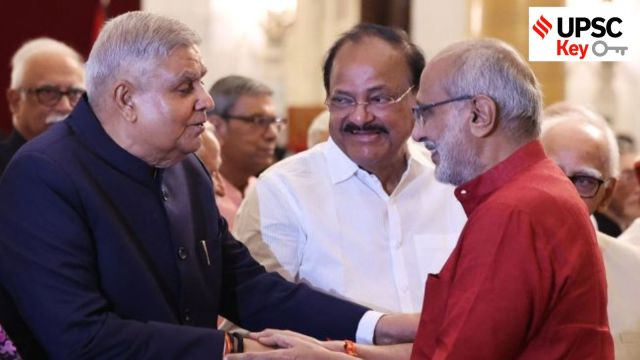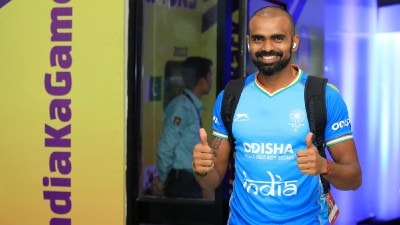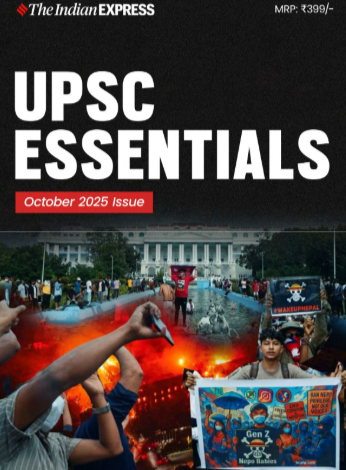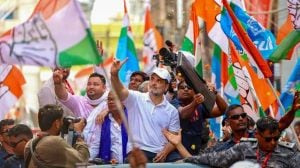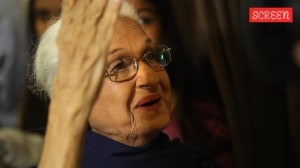
Preliminary Examination: Current events of national importance, Indian Polity and Governance-Constitution, Political System, Panchayati Raj, Public Policy, Rights Issues, etc.
Story continues below this ad
Mains Examination: General Studies-II: Parliament and State legislatures—structure, functioning, conduct of business, powers & privileges and issues arising out of these.
What’s the ongoing story: C P Radhakrishnan was sworn in as the country’s 15th Vice-President in a brief ceremony at the Rashtrapati Bhavan on Friday. President Droupadi Murmu administered the oath of office to the 67-year-old at an event attended by Prime Minister Narendra Modi, several Union Ministers, and other dignitaries.
Key Points to Ponder:
— What are the constitutional provisions related to the office of Vice-President?
— How is the Vice-President of India elected?
— What are the eligibility criteria for Vice-Presidential candidates?
— What is the term of office of Vice-President?
— What are the powers and functions of the Vice-President of India, especially as the ex-officio Chairman of the Rajya Sabha?
Story continues below this ad
— What is the procedure for the removal of the Vice-President of India?
Key Takeaways:
— Hours later, Radhakrishnan met the floor leaders of political parties in the Rajya Sabha — the V-P is the ex officio Chairman of the Upper House — and the Opposition’s representatives were in for a pleasant surprise.
— Radhakrishnan’s predecessor Jagdeep Dhankhar, who resigned in a surprise move on July 21, often had run-ins with the Opposition. So much so that they had given a notice to bring a motion for his removal last year. Given the past rancour, Opposition leaders were keen to urge the new V-P to ensure that the Opposition is given equal space and dignity in the House and its views are heard.
— In his introductory remarks recapping his life journey, Radhakrishnan told the Opposition leaders he would ensure “fair justice” and sought their cooperation. Although the remarks gladdened the hearts of the Opposition leaders, many of them said they would prefer to wait and watch his approach in the House.
Do You Know:
Story continues below this ad
— The Vice-President’s office is a unique feature of India’s parliamentary system and has no exact parallel in other democratic countries, including the Commonwealth.
— The second-highest constitutional authority after the President, the Vice-President draws his/her powers from Article 63 of the Constitution of India, which states that “there shall be a Vice-President of India.”.
— Article 64 goes on to confer upon the post the power to be “ex officio Chairman of the Council of States (the Rajya Sabha).” Thus, we see that Vice-President discharges the duties of both the Vice-President and Rajya Sabha chairperson.
— The Vice-President is elected by an electoral college made up of members from both Houses of Parliament — Lok Sabha and Rajya Sabha — including nominated members. Unlike in a presidential election, state legislatures do not participate.
Story continues below this ad
— Voting is held in Parliament House in New Delhi, by secret ballot, using the system of proportional representation with a single transferable vote. Each MP casts a vote by ranking candidates in order of preference. All votes carry equal value. To be declared elected, a candidate must reach a required minimum number of votes — called the quota.
— A person contesting for the post of Vice-President must be a citizen of India, at least 35 years old, qualified to be elected to the Rajya Sabha, and registered as an elector in any parliamentary constituency. They must not hold any office of profit under the central or state governments, except positions like President, Governor, or Minister.
Other Important Articles Covering the same topic:
📍UPSC Issue at a Glance | Office of Vice-President of India: 5 Key Questions You Must Know for Prelims and Main
Previous year UPSC Prelims Question Covering similar theme:
(1) Consider the following statements: (UPSC CSE 2013)
1. The Chairman and the Deputy Chairman of the Rajya Sabha are not the members of that House.
Story continues below this ad
2. While the nominated members of the two Houses of the Parliament have no voting right in the presidential election, they have the right to vote in the election of the Vice-President.
Which of the statements given above is/are correct?
(a) 1 only
(b) 2 only
(c) Both 1 and 2
(d) Neither 1 nor 2
Previous year UPSC Mains Question Covering similar theme:
Discuss the role of the Vice-President of India as the Chairman of the Rajya Sabha. (UPSC CSE 2022)
Syllabus:
Preliminary Examination: Current events of national and international importance.
Mains Examination: General Studies-II: India and its neighbourhood- relations.
What’s the ongoing story: Ending the political vacuum in Nepal following the fall of the K P Sharma Oli government after violent protests earlier this week, former Supreme Court Chief Justice Sushila Karki was sworn in as the interim Prime Minister on Friday night, making her the first woman to lead the country.
Key Points to Ponder:
— Know about the constitutional history of Nepal.
Story continues below this ad
— Why are the demonstrations in Nepal being called the Gen Z protests?
— What led to the anti-government “Gen Z protests” in Nepal?
— What does nepotism mean?
— What can be the regional implications of Nepal’s ongoing political churn?
— What can be the impact of political instability in Nepal on India-Nepal relations?
— Compare the Bangladesh crisis and the Nepal crisis?
— What is India’s Neighbourhood First Policy?
Key Takeaways:
Story continues below this ad
— Karki, 73, was administered the oath of office by President Ramchandra Paudel who also dissolved the House of Representatives. The interim government has been asked to hold elections to Parliament in six months.
— Karki is likely to expand the Cabinet on Saturday with Kul Man Ghising as the new Energy Minister. An engineer, Ghising, as Chief Executive Officer of the Nepal Electricity Authority, was credited with effective power management and distribution. He was later sacked by Oli.
— Within hours of Karki’s swearing-in, India welcomed the formation of the interim government, saying it was hopeful that this would help in fostering peace and stability in Nepal.
— The Ministry of External Affairs, in a statement, said, “We welcome the formation of a new Interim Government in Nepal, led by Right Honourable Mrs Sushila Karki. We are hopeful that this would help in fostering peace and stability.”
Story continues below this ad
— Earlier, on September 9, within hours of the fall of the Oli government in Kathmandu, Prime Minister Narendra Modi had chaired a meeting of the Cabinet Committee on Security to discuss the situation in Nepal and said the violence there was “heart-rending”. He had also expressed “anguish” that “many young people” had lost their lives in the protests. Underlining that “stability, peace and prosperity” of Nepal was of utmost importance, he had appealed to the people to “support peace”.
— Earlier in the day, Karki made it clear that she would head the interim government only if she was allowed a fair investigation into corruption in high places and excessive use of force by police that led to the death of at least 20 protesters.
— Leaders of the Gen Z protest groups and Kathmandu Mayor Balendra Shah had already endorsed Karki as chief of the interim government. The Gen Z leaders rejected the stance of the three major political parties and warned the President not to undermine them or the message of their movement.
From the Explained Page “Nepal’s ‘Nepo Babies’: Why nepotism is focus of so many public debates”
— “No More Nepo Babies – We Demand Fair Opportunities!” read one banner at Nepal’s youth-led protests, which transformed into an expression of anti-establishment public anger over the past week.
— Even beyond Nepal, the practice of calling out nepotism has been enjoying an extended moment in the spotlight, be it the term “nepo kids” in India or “nepo babies” in the United States.
— The word originated in the mid-17th century from older European words — French népotisme and the Italian nepotismo, which came from the Latin nipote, meaning “nephew”.
— The word has equivalents across languages, such as bhai-bhatijawaad in Hindi (literally, rule of the brother and nephew). Most early societies were feudalistic, with little interest or incentive in practising the values of democracy and equality. Limited resources also meant that those who gained power would do their best to retain it.
Do You Know:
— This is not the first time in the recent past that youth-led movements have toppled regimes in India’s neighbourhood. Last year in Bangladesh, anti-quota protests snowballed into a full-fledged anti-government uprising that ended Sheikh Hasina’s 15-year rule.
— In Sri Lanka, in 2022, corruption and economic mismanagement that led to soaring inflation and acute food and fuel shortages sparked a revolt that brought down the Rajapaksa family.
— India should continue to monitor the situation in its neighbourhood and remain vigilant. In the wake of the turmoil in Nepal, New Delhi should keep a close watch on how the political situation in the country unravels. It should be alert to a Bangladesh-like regime change and be ready to safeguard India’s interests amid the flux.
Other Important Articles Covering the same topic:
📍Why is Kathmandu burning?
📍Kathmandu irresolution
Previous year UPSC Prelims Question Covering similar theme:
(2) Consider the following pairs: (UPSC CSE 2016)
|
Community sometimes mentioned in the news |
In the affairs of |
| 1. |
Kurd |
Bangladesh |
| 2. |
Madhesi |
Nepal |
| 3. |
Rohingya |
Myanmar |
Which of the pairs given above is/are correctly matched?
(a) 1 and 2 only
(b) 2 only
(c) 2 and 3 only
(d) 3 only
EXPLAINED
Syllabus:
Preliminary Examination: Current events of national and international importance.
Main Examination: General Studies-II, III: Functions and responsibilities of the Union and the States, issues and challenges pertaining to the federal structure, Linkages between development and spread of extremism and Role of external state and non-state actors in creating challenges to internal security.
What’s the ongoing story: Prime Minister Narendra Modi will fly to Manipur on Saturday and interact with internally displaced people in Churachandpur and Imphal. This will be the Prime Minister’s first trip to the state since the ethnic conflict between the Meitei and Kuki-Zo communities began in May 2023.
Key Points to Ponder:
— What is the cause of ethnic violence in Manipur?
— What is the Suspension of Operations (SoO) agreement?
— Examine the role of ethnic and communal tensions in the North-eastern region of India with a focus on the Manipur conflict.
— What are the socio-political and historical reasons for persistent violence in the North-eastern states of India?
— What measures can the government take to ensure peace and harmony in the Northeast region?
Key Takeaways:
— In the 27 months since, Manipur has witnessed prolonged periods of violence and displacement, a collapse of law and order, the strengthening of armed groups, a Lok Sabha election, the imposition of President’s Rule, and, recently, a gradual ebb in the violence. Here are 5 key issues in the state, and where they stand today.
— Rehabilitation of displaced population: More than 280 relief camps across Manipur house some 57,000 internally displaced people, many of whom have been living there for over two years now. Broadly, there are two categories of displacement that have taken place.
— In July, then Chief Secretary P K Singh had announced an ambitious three-phase resettlement plan aimed at winding down all the relief camps by the end of the year.
— Free movement in the state: Through the course of the conflict, the boundaries between valley and hill districts have hardened, and individuals from neither community have been able to safely travel in areas where the other community is in majority. These boundaries are heavily manned by security personnel and have come to be called “buffer zones” between the two communities.
— Now, while Kuki-Zo groups have largely agreed to cooperate with the movement of essential goods to the valley through the highways, they continue to state that they will not allow the movement of Meiteis across “buffer zones”. No similar agreement or commitment has been arrived at with Meitei groups for the movement of Kuki-Zo people in the valley.
— Dialogue between communities: For over one-and-a-half years, the state lived with deadly violence between the two communities in which more than 250 lives have been lost. The last such deadly cycle took place in November 2024, and the violence has ebbed since.
— Currently, the Ministry of Home Affairs is engaging in talks with groups on both sides separately, and last week renewed a Suspension of Operations (SoO) pact with Kuki-Zo insurgent groups under the umbrellas of Kuki National Organization and the United People’s Front.
— Government formation: There has been a growing push from valley-based and Naga NDA MLAs for the restoration of a popular government in the state citing “public demand” and “pressure.” Centre, however, has indicated no inclination to lift President’s Rule, unwilling to destabilise the current status quo.
— The border situation: The state’s porous international border with Myanmar has been a prickly issue in context of the conflict. Meitei stakeholders have continuously alleged that unregulated illegal immigration of Chin people from Myanmar — who share a common ethnicity with the Kuki-Zo — has been a major cause for volatility in the region.
— The Centre decided to scrap the Free Movement Regime with Myanmar — which allowed tribes living along the border on either side to travel up to 16 km inside the other country without a visa and stay up to two weeks — and announced that the porous border will be fenced.
Do You Know:
— The Suspension of Operations (SoO) agreement is essentially a tripartite ceasefire deal to initiate political dialogue. Signed in 2008, the agreement was between the Centre, the Manipur state government, and the KNO and the UPF, two umbrella groups comprising 24 separate Kuki-Zomi insurgent groups.
— The SoO agreement with militant groups under the umbrellas of Kuki National Organisation (KNO) and United People’s Front (UPF) has been renewed with renegotiated terms.
Other Important Articles Covering the same topic:
📍Two steps forward in Manipur
EXPRESS NETWORK
Syllabus:
Preliminary Examination: Current events of national and international importance.
Mains Examination: General Studies-II, III: Government policies and interventions for development in various sectors and issues arising out of their design and implementation, Conservation, environmental pollution and degradation, environmental impact assessment.
What’s the ongoing story: The Union Environment Ministry has approved the capture of eight tigers from the Tadoba-Andhari and Pench reserves for their translocation to the Sahyadri Tiger Reserve in western Maharashtra, a move aimed at reviving the big cat’s population in the northern Western Ghats.
Key Points to Ponder:
— What is the status of Tigers in India?
— How do tigers function as an umbrella species and why is their conservation critical for biodiversity?
— Know about the Sahyadri Tiger Reserve, Tadoba-Andhari and Pench reserves
— What is Project Tiger?
— What is the role and function of the National Tiger Conservation Authority?
— What are the major tiger reserves in India?
— What is the conservation status of Tiger?
— What is the International Big Cat Alliance?
Key Takeaways:
— The ministry’s Wildlife Division on Thursday gave the green light to the Maharashtra Chief Wildlife Warden for capturing tigers, subject to certain conditions.
— Key among these conditions are a provision of adequate veterinary care at all stages of capture and translocation, and care to prevent post-capture complications. The Wildlife Division also told Maharashtra officials to ensure minimal trauma to tigers during the operation.

— The ministry’s approval is learnt to have come after the Wildlife Institute of India (WII), which is working with the Sahyadri reserve’s field staff, gave a positive appraisal of the preparations to host translocated tigers.
— Initially, two tigresses will be translocated from the Tadoba Tiger Reserve, said Tushar Chavan, the field director of the Sahyadri reserve.
— The translocated tigers will first be put in a temporary enclosure — known as a soft release — before being released into the wild. Studies carried out by WII and state forest department have shown that the Sahyadri reserve can be home to over 20 tigers.
— The technical committee of the National Tiger Conservation Authority (NTCA) had recommended approval for the translocation project in October 2023.
— The translocation is part of the second phase of the long-term tiger recovery plan being implemented in the Sahyadri Tiger Reserve. In the initial stage, the state forest department and WII worked to strengthen the forest habitat and prey base.
Do You Know:
— The Sahyadri Tiger Reserve, named after the Sahyadri range in the Western Ghats, is spread over 1,165 sq km, straddling Kolhapur, Sangli, Satara and Ratnagiri districts. It was notified in 2010, combining the Chandoli National Park and Koyna Wildlife Sanctuary area.
— But despite its rich forest vegetation, breeding tigers have never colonised the reserve. Field staff have recorded a largely transient tiger population, which disperses in forests around the reserve.
— As per the NTCA’s management effectiveness evaluation of tiger reserves, the Sahyadri Tiger Reserve forms the catchment for Koyna and Warna rivers, which are crucial for livelihoods in neighbouring districts.
— Notably, a tiger reserve in India is a designated area established under the Project Tiger initiative to ensure the conservation of tigers and their habitats. These reserves are part of the government’s efforts to protect the tiger population, maintain biodiversity, and restore ecological balance.
— The NTCA is a statutory body under the Ministry of Environment, Forests and Climate Change constituted under enabling provisions of the Wildlife (Protection) Act, 1972, for strengthening tiger conservation, as per powers and functions assigned to it under the said Act.
— The IUCN status of the tiger is endangered, and it is protected under Schedule I of the Wildlife Protection Act, 1972.
Other Important Articles Covering the same topic:
📍UPSC Issue at a Glance | Why Tigers Matter: Environmental, cultural, and economic significance of India’s apex predator
Previous year UPSC Prelims Question Covering similar theme:
(3) Among the following Tiger Reserves, which one has the largest area under “Critical Tiger Habitat”? (UPSC CSE 2020)
(a) Corbett
(b) Ranthambore
(c) Nagarjunasagar-Srisailam
(d) Sundarbans
(4) The term ‘M-STrIPES’ is sometimes seen in the news in the context of (UPSC CSE 2017)
(a) Captive breeding of Wild Fauna
(b) Maintenance of Tiger Reserves
(c) Indigenous Satellite Navigation System
(d) Security of National Highways
THE IDEAS PAGE
Syllabus:
Preliminary Examination: Current events of national and international importance.
Mains Examination: General Studies-II: Effect of policies and politics of developed and developing countries on India’s interests.
What’s the ongoing story: Anju Gupta writes- “On September 9, Israel mounted aerial strikes on a residential complex in a diplomatic area of Doha, the capital of Qatar. The complex housed the political office of Hamas where a meeting was in progress to discuss the US proposal on Gaza. The Hamas negotiators and leaders were not in the building which was targeted, but a few functionaries and a Qatari security officer were killed.”
Key Points to Ponder:
— Read about the Israel-Hamas conflict.
— Know about the ceasefire talks related to the Israel-Hamas.
— What is a two-state solution?
— What role has Qatar traditionally played as a mediator in West Asian conflicts?
— What are the Abraham Accords?
— How might the Israeli strike affect Qatar’s reputation as a neutral mediator?
— What are the implications of the Israeli strike on Doha for the ceasefire process in Gaza?
— Know about India’s relations with Qatar and Israel.
— Map work: Locate Qatar, Israel and other places in news related to Israel-Hamas conflict.
Key Takeaways:
— “Qatar affirmed that the Hamas office was functioning on the American request to facilitate dialogue. The next day, accusing Qatar of providing money and safe harbour to Hamas, Israeli Prime Minister Benjamin Netanyahu warned of more strikes against Hamas’s “safe haven” in Qatar and elsewhere. Amid hostilities between two of the US’s closest allies in the region, the critical question is not what role the US played, but what options Qatar and the Arab states have.”
— “Qatar publicly declared that on the US’s request, it had allowed the Hamas political office in Doha to keep channels of communication open. Qatar also accepted a US request to host Taliban representatives to facilitate intra-Afghan reconciliation and permitted the Taliban to open a political office in Doha in 2013. A trusted US ally, Qatar has visibly played a facilitator for talks with the Taliban and a mediator with Hamas for the release of Israeli hostages and a ceasefire in Gaza.”
— “Qatar is home to the largest American military base in the region. A nerve centre of the US Central Command (CENTCOM), the Al Udeid base oversees and defends US interests and that of allies in the region, including in Pakistan and Afghanistan. The over-the-horizon US counter-terrorism capability resides here too. Qatar is an indispensable logistical base for CENTCOM operations and in turn, a beneficiary of the US security umbrella. Any violation of Qatari air space would be a prime security concern for CENTCOM.”
— “US officials have explained that the American military informed the White House about the strikes shortly before they happened, and this was conveyed to Qatar. In a call to the Qatari Emir, condemning the strikes and claiming no prior knowledge, Trump assured that there would be no repetition. However, by threatening Qatar the very next day, Netanyahu has publicly negated the assurance.”
— “The Sunni Arab leadership, including Saudi Arabia and the UAE have strongly condemned the attacks. Most of these states also host US bases or troops. They have all more or less lived under the US security umbrella since Iraq’s invasion of Kuwait in 1990. The top question for them must be whether the American protective umbrella was only against “potential” Iranian aggression. Will the Sunni Arab states rescind the Abraham Accords and similar instruments with Israel? With Israel playing a regional “super cop”, it remains to be seen how the Sunni Arab states can come together to force the US to contain Israeli aggression and/or look for other options over the mid- to long- term.”
— “The Israeli action is likely to further unite the region and may result in greater political and economic alignment with the Russia-China duo.”
— “The international pressure on halting the war in Gaza and pursuing a two-state solution has never been as high on Israel as it is now. Following the recognition of the State of Palestine by several countries in the middle of the war in 2024, seven western countries, namely the UK, Australia, France, Belgium, Malta, Canada and Portugal, have pledged to do the same at the UN General Assembly in September. The UK too has set a few conditions. The US and Israel have condemned such pledges, but if actualised, they would lead to a near total political isolation of Israel and the US on Palestine.”
Other Important Articles Covering the same topic:
📍Israel’s attack on Doha
Previous year UPSC Prelims Question Covering similar theme:
(5) The term “two-state solution” is sometimes mentioned in the news in the context of the affairs of (UPSC CSE 2018)
(a) China
(b) Israel
(c) Iraq
(d) Yemen
Previous year UPSC Mains Question Covering similar theme:
“India’s relations with Israel have, of late, acquired a depth and diversity, which cannot be rolled back.” Discuss. (UPSC CSE 2018)
|
ALSO IN NEWS
|
| More reliance on surveillance among measures to reduce trust deficit at LAC |
Indian troops deployed along the Line of Actual Control (LAC) in eastern Ladakh are working on reducing the trust deficit with Chinese troops on the ground by implementing additional confidence-building measures, which include greater reliance on the technical surveillance infrastructure that has been put in place over the last five years. According to sources, since 2020 when the military standoff began in eastern Ladakh, India has established a comprehensive surveillance network to extensively monitor the LAC and surrounding areas round the clock. This is being further upgraded and strengthened, with the long-term aim of reducing additional patrolling effort. |
| Decide on bail pleas within two months, Supreme Court tells HCs |
The Supreme Court on Friday directed high courts to decide on bail applications within a period of two months, except in cases where “delay is attributable to the parties themselves”. The bench of Justices J B Pardiwala and R Mahadevan stated that “applications concerning personal liberty cannot be kept pending for years while the applicants remain under a cloud of uncertainty.” The order was made while upholding a Bombay High Court order dismissing anticipatory bail pleas of those accused in a case of cheating and forgery of property documents. |
| Brazil’s Bolsonaro convicted of coup attempt: What to know |
The majority of a panel of Brazilian Supreme Court justices on Thursday voted to convict former president Jair Bolsonaro of attempting a coup to remain in office despite his 2022 electoral defeat. The far-right politician who governed Brazil between 2019 and 2022 was found guilty on five counts by three members of a five-justice panel. |
Subscribe to our UPSC newsletter. Stay updated with the latest UPSC articles by joining our Telegram channel – Indian Express UPSC Hub, and follow us on Instagram and X.
🚨 Click Here to read the UPSC Essentials magazine for August 2025. Share your views and suggestions in the comment box or at manas.srivastava@indianexpress.com🚨

